Insights
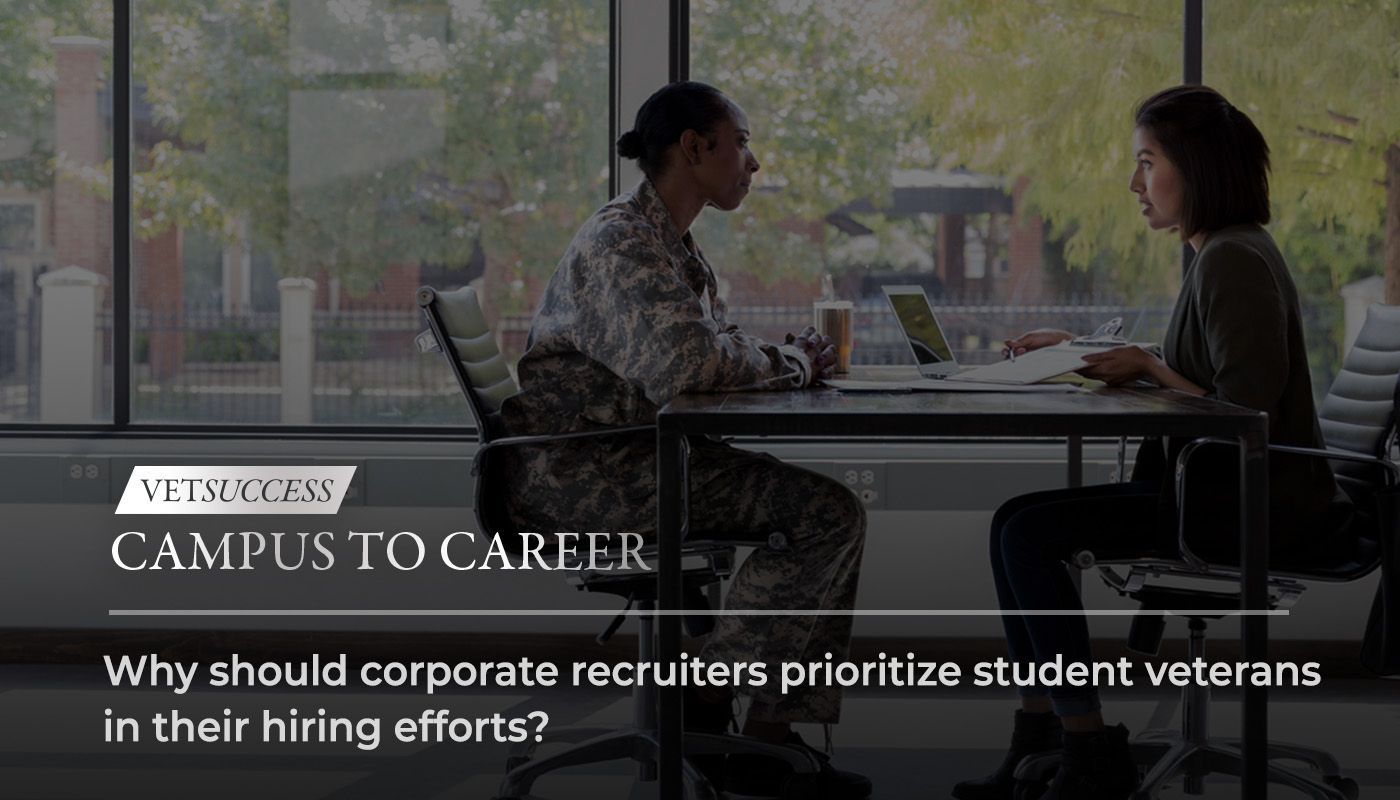
By Ben Biles
•
16 Apr, 2024
With 48% of companies ranking recruiting top talent, and 68% reporting difficulty reaching ideal candidates in the recruitment process, organizations are looking for ways to optimize their talent attraction strategies and processes. Prioritizing the recruitment of student veterans is one way that corporate recruiters can tap into a top talent pool that is often overlooked in companies’ recruitment efforts. From excellent academic achievements to prior work experience, here is why recruiters should prioritize student veterans in their hiring efforts. On average, student veterans outperform their non-veteran peers academically. Student veterans are more likely to pursue and graduate with highly sought after business and STEM degrees. Beyond attaining degrees in demanding and complex fields of study, student veterans also earn, on average a 3.35 GPA , in comparison to the non-veteran student average GPA of 3.11. Student veterans have a proven professional track record. Organizations that learn to translate military experience and identify transferrable skills gain a major competitive advantage; many companies overlook or misplace veteran hires because they don’t know what various responsibilities and jobs in the military entail. Student veterans have a proven professional track record from their time in the service, and advanced degrees. While their working experience is specific to the military, the transferrable skills student veterans have developed make them stand out from their non-veteran student peers. Student veterans are diverse candidate pool. The majority of employees report that their employers need to do more to increase diversity at their organizations. Prioritizing the hiring of student veterans enhances diversity and inclusion initiatives within organizations by encouraging inclusive hiring practices and processes. The student veteran pool is made up of a diverse set of candidates, with different backgrounds, creeds, ethnicities; by targeting student veterans, recruiters and organizations can enhance their organizations’ approach to intersectional, inclusive hiring. Military experience instills highly-desirable qualities in student veteran candidates. Student veterans typically have many of the qualities corporate recruiters and hiring managers prioritize in candidates; these qualities are indicative of candidates’ potential and anticipated contribution to an organization. Military service cultivates and requires a strong work ethic , leadership skills, reliability, loyalty, teamwork, problem-solving skills, time-management, and organization. These soft skills, coupled with advanced academic achievement and prior work experience, make for highly desirable candidates. Recruiting top talent is a highly time-intensive, expensive undertaking. As corporate recruiters and hiring managers are considering how to get the most out of their investment in talent, finding candidates who possess both the hard and soft skills that will help make their organizations thrive, prioritizing student veterans in recruitment strategies should be a priority . To learn more about how to best tap into the student veteran talent pool, join American Veterans Group for its virtual panel discussion – VetSuccess: Campus to Career – on April 24, 2024 from 1:00-2:00 pm EST.
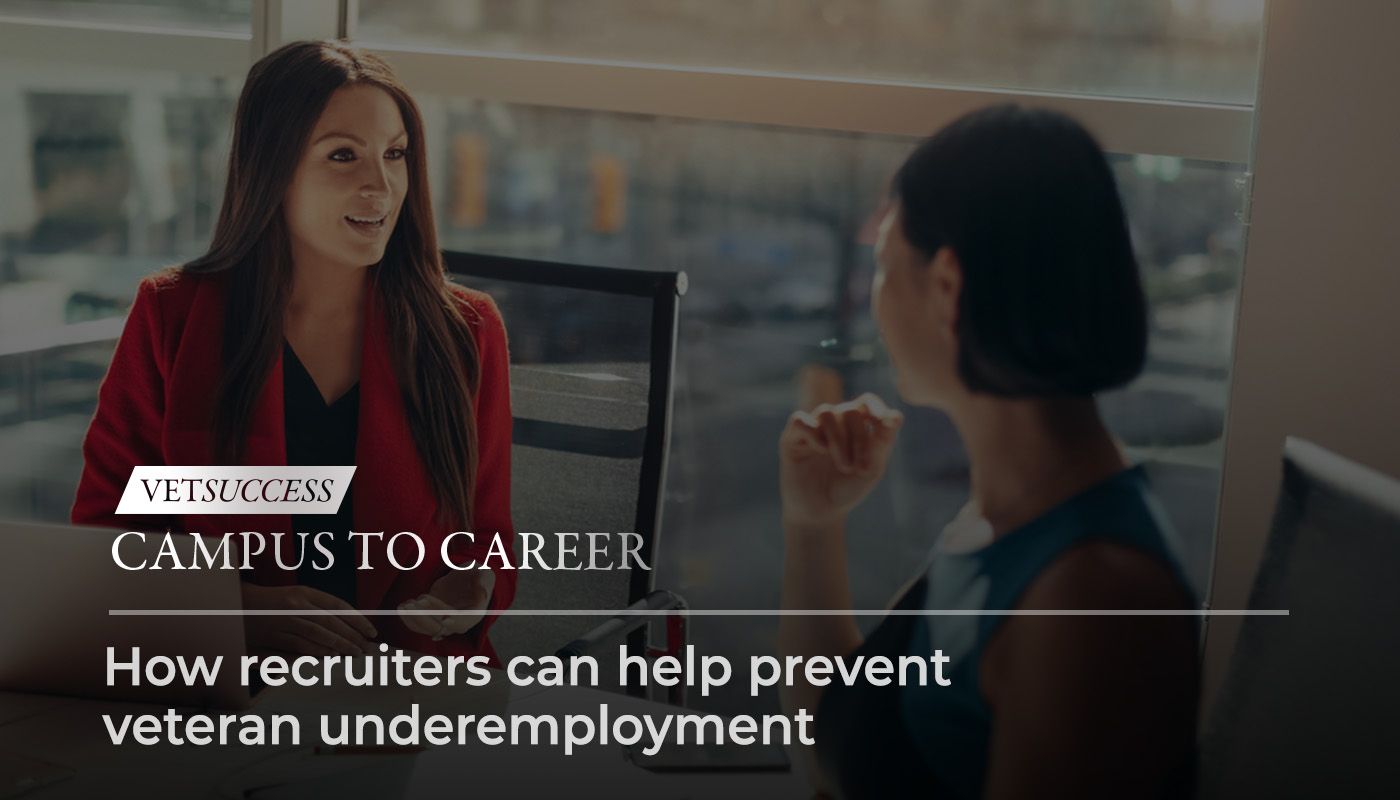
By Ben Biles
•
04 Apr, 2024
Today's corporate landscape is missing out on a valuable, yet untapped resource: military veterans. Despite serving in various professional fields and career levels within the military, veterans are still an undervalued talent pool in today’s workforce. According to a recent study by ZipRecruiter and the Call of Duty Endowment, 33% of veterans experience underemployment – meaning they are significantly overqualified for their current position. Despite valuable experience from years of military service, veterans are 15.6% more likely to be underemployed than their non-veteran peers. This doesn’t just apply to veterans entering the civilian workforce straight out of service – veterans with college degrees face underemployment too. Veterans with bachelor’s degrees enter the corporate workforce with twice as much work experience than non-veterans with the same level of education, according to LinkedIn’s “Veteran Opportunity Report.” They’re also three times more likely than non-veterans to have a graduate degree or higher. "Veterans with bachelor’s degrees enter the corporate workforce with twice as much work experience than non-veterans with the same level of education...Despite this, veterans are half as likely as non-veterans to reach senior leadership roles in the corporate world – and even when promoted, their progression is notably slower than their peers." Despite this, veterans are half as likely as non-veterans to reach senior leadership roles in the corporate world – and even when promoted, their progression is notably slower than their peers. According to the same LinkedIn report, on average, it takes veterans two more years than non-veterans to reach their first director or vice president position. This disparity often begins at the campus recruiting level , where student veterans find themselves in entry-level positions that fail to leverage their skills and potential. The disconnect between the skills acquired in the military and the civilian labor market exacerbates this issue, leading to prolonged delays in professional development. Though student veterans may not have experience in a civilian workplace, many have developed critical professional skills during their time in the military that are simply incomparable to the typical college graduate. To combat this critical mismatch, company recruiters must adopt a skills-first strategy when working with student veterans to ensure they are being placed in positions that are appropriately challenging and make the best use of their skills and experience. Skills-first hiring isn't just an act of goodwill for the veteran talent pool — it's a strategic decision for employers. Skills-first hiring can help employers: • Expand their talent pools • Improve equity and representation • Create a workforce adaptable to the changing labor market • Meet the skills demands of changing industries • Bridge the opportunity gap between veterans and non-veterans Military veterans are ready to apply their skills and experience in the civilian workplace but hiring processes are not always ready for them. By being intentional and strategic about veteran hiring, companies can tap into this diverse talent pool and unlock unparalleled value, foster innovation, and promote a culture of inclusivity and growth. To learn more about how to advance student veteran employment, join American Veterans Group's virtual panel discussion, VetSuccess: Campus to Career on April 24, 1-2 pm EST.
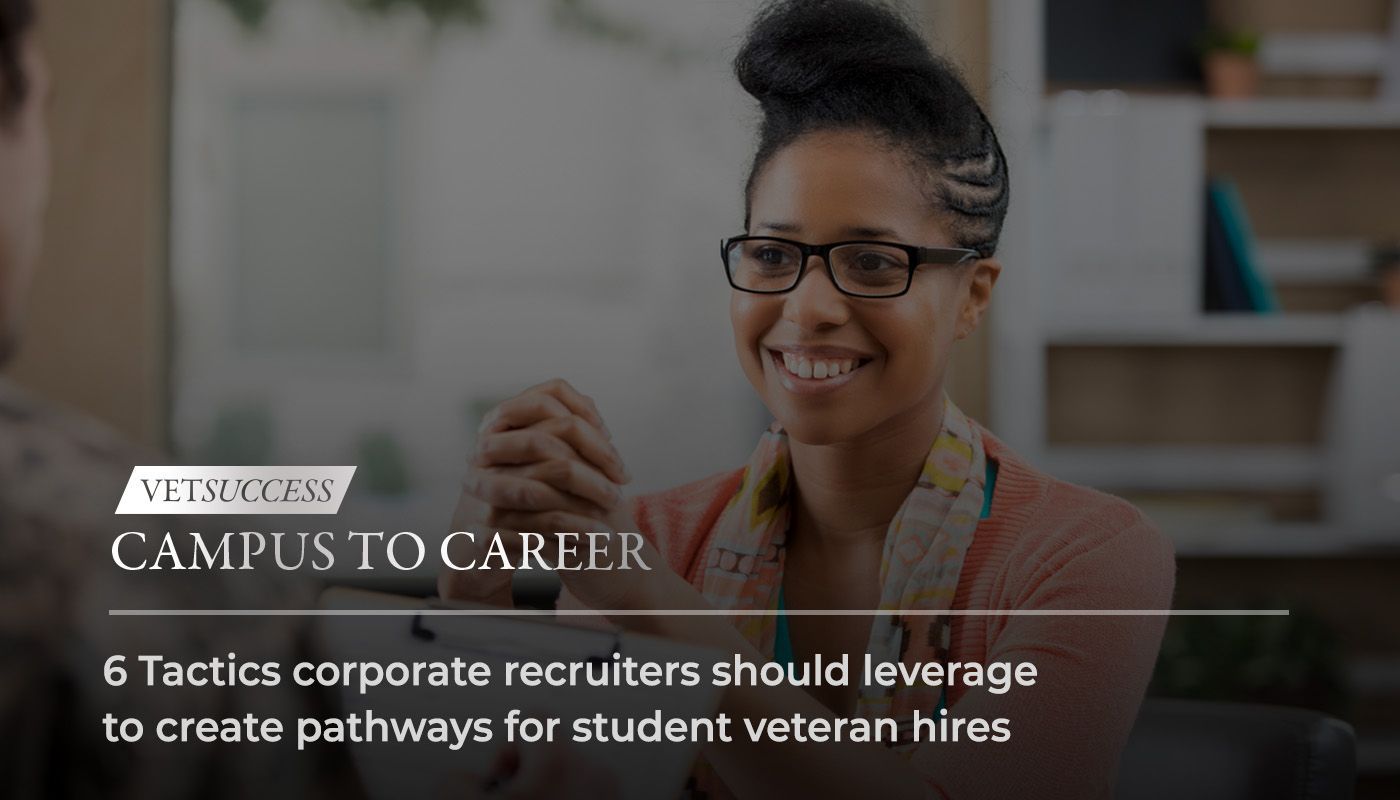
By Ben Biles
•
28 Mar, 2024
More than half of the 200,000 veterans who leave the service each year turn to higher education, with 115,000 veterans enrolling in college annually. Student veterans represent a highly-skilled, competitive talent pool, combining advanced degrees with years of working experience from their time in the service. However, corporate recruiters often struggle to determine how to identify and connect with student veteran candidates, who are more likely than their non-veteran peers to live off-campus, work full or part-time jobs, and have families. While advancing student veterans’ civilian career prospects requires a concerted and coordinated effort by both higher education institutions and hiring organizations, corporate recruiters can more effectively create pathways for student veteran hires using the following tactics. Connect your veteran and early career resources internally. If companies have resources and personnel dedicated to military veteran recruiting and early career recruiting, it is critical that these two entities collaborate. While military veteran recruiters within companies typically have some experience translating military experience, understand military rank and structure, and may be veterans themselves – the early career programs recruiting student veterans likely do not. Conversely, early career recruiters have relationships with universities, have experience connecting with students, and may be more familiar with working with candidates just starting out in civilian careers. The expertise both groups bring to the table makes it more likely that your organization will effectively connect and engage with military veterans, speaking to the unique circumstances and background of this candidate pool. Offer flexible or alternative options to the traditional summer internship. 47% of veteran students have families , and 50% are working full-time throughout school. Consequently, the 12-week summer internship program that many companies offer, designed to fit the more traditional student demographic, is untenable for many student veterans. Providing alternative options like apprenticeships or part-time student roles gives student veterans the chance to get their foot in the door. Take another look at your target schools list. Companies have finite resources to recruit early career candidates. As a result, most organizations will identify target schools, typically those that are geographically proximate to company offices or headquarters, to focus their recruitment efforts on. However, if organizations are looking to specifically recruit student veterans, it’s critical that they include colleges with a student veteran population. Companies should also not necessarily limit their recruitment efforts to four-year institutions; including community colleges and trade schools in your company’s recruitment strategy can create pathways for even more high-quality student veteran candidates. Offer a mix of on-campus and virtual recruiting events. With the diverse needs and circumstances of student veterans, it's prudent to provide networking and recruiting events that aren’t strictly in-person, or on-campus. With many student veterans living off-campus, and potentially less plugged in to on-campus events, companies that offer a healthy mix of in-person and virtual events are more likely to connect with student veterans who may otherwise miss out due to family or work commitments. Stay mindful of skill-matching to prevent student veteran underemployment. Though student veterans may not have experience in a civilian workplace, many have years of work experience through the military, developing critical professional skills that are simply not comparable to the typical 22-year-old college graduate. Veterans are 15% more likely to be underemployed than their non-veteran peers, with 33% of veterans experiencing underemployment. Recruiters need to prioritize skill-matching when working with student veterans to ensure they are being placed in positions that are appropriately challenging and make the best use of their skills and experience. Coordinate with other companies. Collaborating with other companies that share a commitment to hiring and supporting veteran talent can amplify recruitment efforts and expand opportunities for student veterans. This collaborative approach benefits individual companies and strengthens the broader support network for student veterans transitioning into the workforce. Working to advance military veteran employment, and opening pathways for student veterans requires collaboration across the education, private, and public sectors. Together, organizations can move the needle and enhance outcomes for veterans throughout their transition to their civilian life and careers. To learn more about how to improve employment prospects for student veterans, join American Veterans Group’s virtual panel discussion, VetSuccess: Campus to Career on April 24, 2024 1-2pm EST .
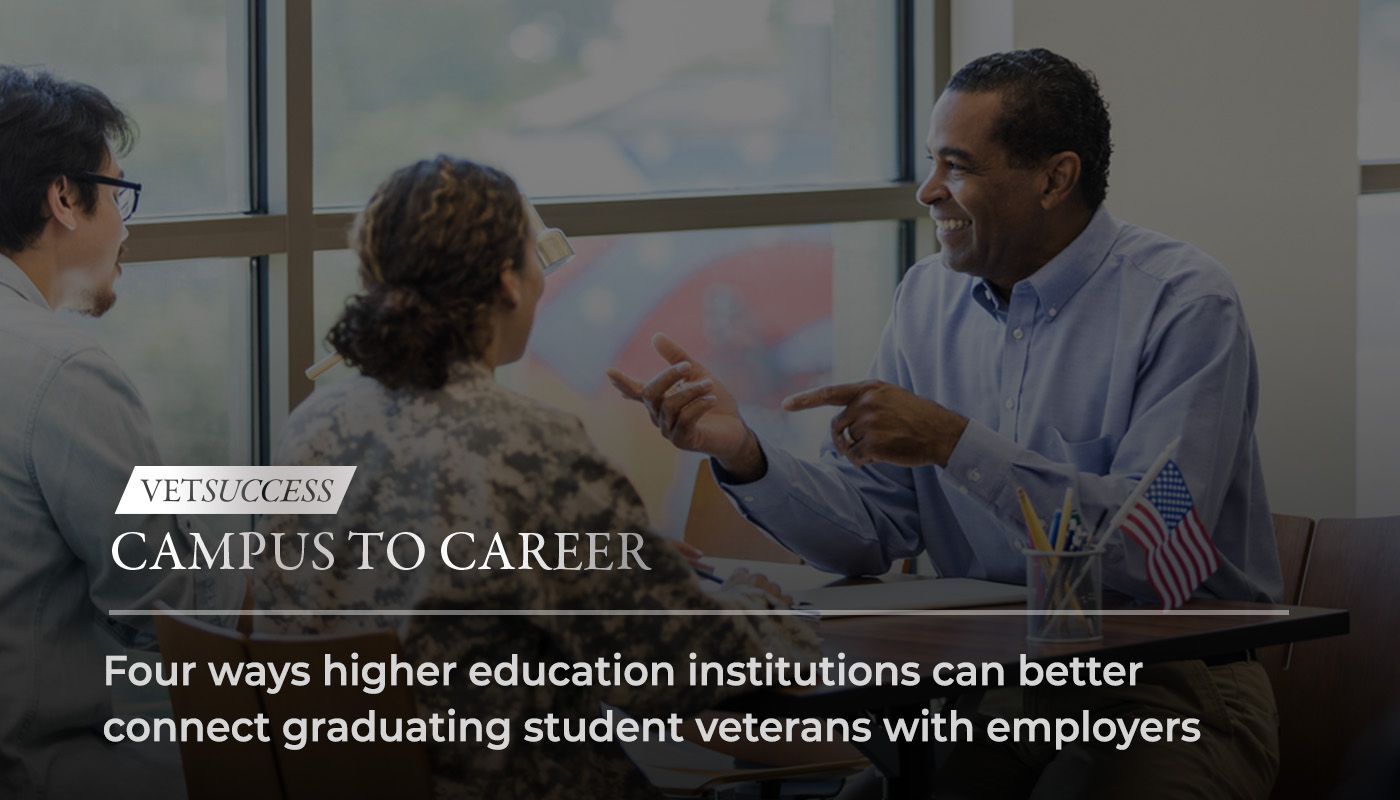
By Ben Biles
•
19 Mar, 2024
Transitioning from military to civilian life can be daunting, especially for veterans who choose to pursue an undergraduate degree after their military service. Student military veterans account for three-to-four percent of U.S. college students and more than 2.9 million veterans have entered higher education in the post-9/11 era, according to Student Veterans of America. It’s a unique population – and higher education institutions can better-serve veterans by connecting graduating student military veterans with employers and supporting their transition from military service to civilian life. Ensure Your Institution Has Military Support Services and Resources Institutions that want to ensure that military veterans are empowered and supported on campus need to have adequate services and resources avaliable to this small student population. Dedicated student veteran services, with advisors who understand the distinctive needs and challenges they face during their transition to civilian life, are paramount to an institution’s ability to serve its student veterans. These services may include academic advising, career counseling, and assistance with VA benefits, and should ensure that students have access to career development, mental health, and financial aid resources. These services not only provide critical support to veteran students, but provide deeper insight for institutions into this segment of the student body. Facilitate Networking Opportunities Student veterans face unique challenges that often prevent them from accessing opportunities typically avaliable to traditional college students. Veterans in higher education juggle many roles. They are statistically more likely to be older than other college students, and are likely employed, and married and/or supporting a family. According to the VA, 75% of student veterans are taking courses full time, and are twice as likely to hold off campus jobs. With various off-campus responsibiliites, most student veterans are unable to take unpaid internships – a luxury typically afforded to traditional students that are financially supported through school. Facilitating networking opportunities this student population not only enables veterans on campus to build a professional network that may otherwise be out of reach, but celebrates their perspectives and skillsets. Establish Partnerships With “Veteran-Friendly" Employers Creating partnerships with employers who prioritize hiring military veterans is essential for higher education institutions aiming to facilitate the transition of graduating student veterans into the civilian workforce. Employers are increasingly recognizing the value that military veterans bring to their organizations. Companies are beginning to understand that hiring veterans doesn’t just provide their workforce with employees that have valuable skills and experiences, but also contributes to fostering a diverse and inclusive workplace culture. Identifying and collaborating with employers in your region that actively seek to hire military veterans is key. These employers are not only accommodating to a veteran workforce but also prioritize it as part of their recruitment strategy. By partnering with such organizations, higher education institutions can create a pipeline of job opportunities specifically tailored to graduating student veterans. Celebrate And Promote Military Veteran Talent Institutions have the ability (and deep networks) to provide a massive platform for jobseekers. In today's competitive job market, it's crucial to amplify the valuable, transferable skills that military veterans bring to the table. These skills – including leadership, teamwork, adaptability, and problem-solving – are highly sought after by employers across various industries. By actively promoting the talents and experiences of veterans, institutions not only advocate for the employment of veterans but also help employers recognize the immense value they can bring to their organizations. Institutions can leverage their platforms to showcase the achievements and success stories of graduating veteran students. By shining a spotlight on the achievements of veteran students, institutions not only demonstrate their support for the veteran community but also provide tangible evidence of the caliber of talent available among graduating veterans. By implementing these practices, accredited colleges and universities can play a pivotal role in a veteran's life as they transition from military life, to undergraduate, and into civilian careers. To learn more about how higher education institutions can better collaborate with corporate recruiters and advance employment for the veterans students on their campus, join American Veterans Group’s virtual conference on April 24th, 2024 1-2pm.
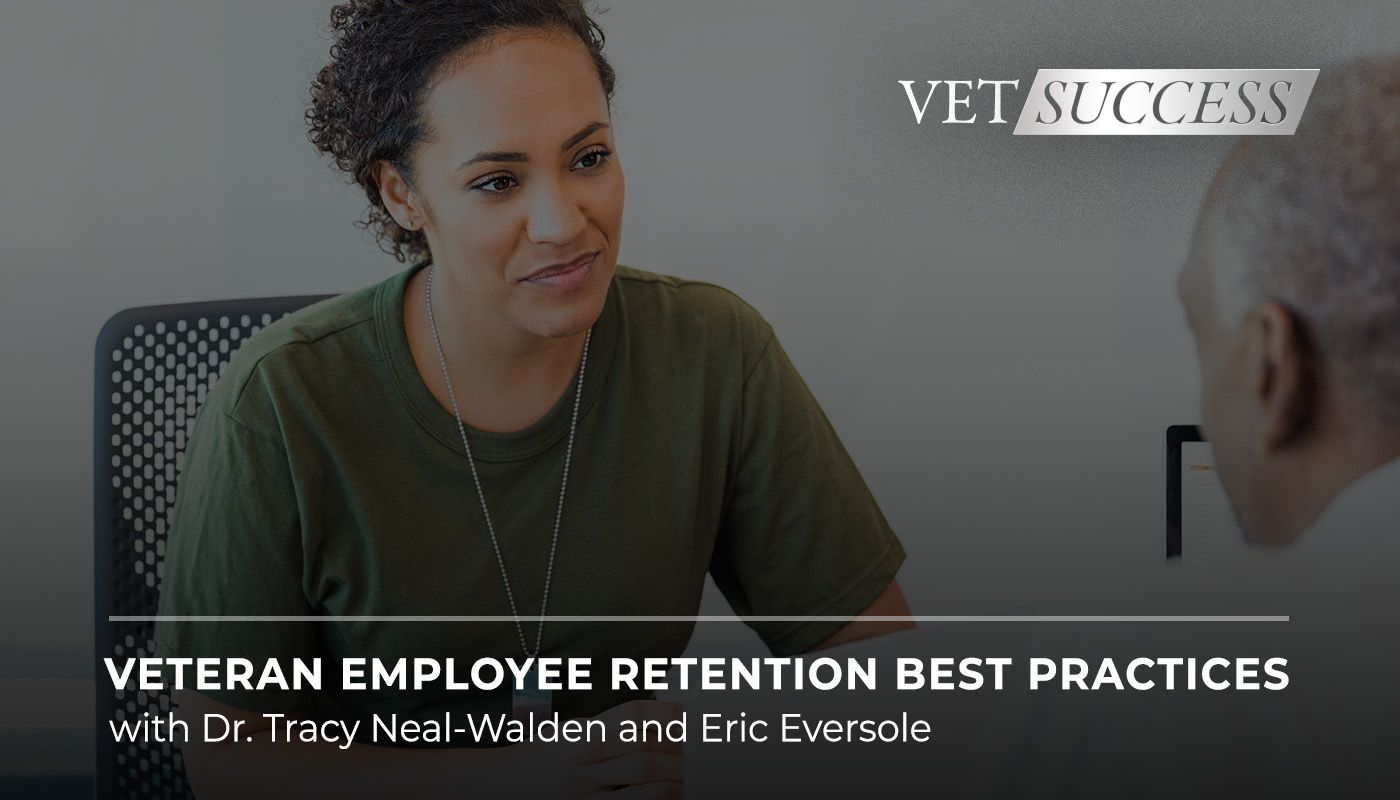
By Ben Biles
•
05 Oct, 2023
The competition for talent is intense. Some of the factors contributing to this competition include brain drain in major economic hubs , job seekers’ prioritization of work-life balance and purpose-driven employers, and the expansion of remote and hybrid work options. With the competition for talent more pressing than ever, organizations need to invest in retaining their top talent, particularly veterans, who are 39% more likely to be promoted than their nonveteran peers and have 2.9 times more work experience on average. While many companies are still looking to improve their processes specific to military veteran recruitment, many of the best practices for employee retention can be applied to keep veteran employees on board. American Veterans Group discussed the broadly applicable, and more nuanced considerations of military veteran retention with Dr. Tracy Neal-Walden, chief clinical officer at Cohen Veterans Network , and Eric Eversole, vice president of the U.S. Chamber of Commerce and president of Hiring our Heroes . Meet people where they are, and look for the right fit. While veterans, of course, share the experience of having been in the military, their life experience prior to active service, position and length of service, and process for transitioning back to civilian life varies greatly. Employers should consider this diversity of experience, skill, and background, as they seek to recruit and retain veteran employees. As Eric Eversole says, “there is no one-size-fits-all approach to how we help service members transition.” The key, Eversole shared, is to meet people where they are. “We really focus on the that model, meeting people where they are, not where we want them to be. We’ll get them there and figure out what the pathway looks like based on their unique needs.” -Eric Eversole Meeting veteran job seekers where they are and assessing individual strengths and transferrable skills is critical to ensuring that veterans are hired into the right positions. As reported by Forbes , employees across the board expect a personalized, high-quality employee experience, throughout their job search, onboarding, and professional development. This personalization is perhaps even more applicable to veteran job seekers however, as they are 38% more likely to be underemployed than nonveterans . Employers can use programs like apprenticeships and internships to get to know their veteran candidates better, and ensure they are hired into positions that best fit their skillsets. “We have to start to evaluate talent and skillsets beyond a piece of paper, and the best way to do that is to get up close and personal. It allows companies to really evaluate military talent in the workforce … and to better understand what level to bring the person in, how they’re going to fit in, and whether they’re going to be a good fit” - Eric Eversole Drive home your company’s mission and purpose. As millennials and Gen-Z comprise an increasing portion of today’s workforce, the power – and business proposition – for purpose-driven companies has increased significantly as a primary driver for employee engagement and performance . The importance of organizations' missions and employees’ sense of purpose is highly relevant to veteran job seekers as well. The military has a very clear mission and active service members have clarity on exactly how their day-to-day activities contribute to that overarching mission. Veterans often value that same sense of purpose and clarity in their civilian careers. “Veterans want to have a strong mission, and to feel like they’re making a difference.” - Dr. Tracy Neal-Walden Organizations should emphasize their mission in their employee branding , and specifically call out the role the veteran job seeker, or hire, plays in driving the mission forward. Provide continual feedback and development opportunities. With a clearly defined structure for rank and advancement in the military, many veterans are accustomed to more rigid promotion and evaluation processes, and professional development opportunities and requirements. “It is inherent for most veterans, because when you’re in the military, you continue to advance in your rank, and with those advancements comes additional coursework, so you continue to learn and grow throughout your career.” - Dr. Tracy Neal-Walden Having clearly defined and regular performance review opportunities, sharing upskilling and professional development resources and programming, and plugging veteran employees into mentorship networks are valuable ways to keep veteran employees, and employees in general for that matter, engaged and dedicated to the organization. Veterans, like civilian employees, are ultimately looking for employment in which they are adequately challenged, feel a sense of purpose and mission, and have opportunities for growth and advancement. And while there is not a silver bullet for veterans’ transition to civilian life, meeting people where they are and investing in getting it right for the individual will ultimately pay back dividends. If you’re interested in more specific feedback and guidance on how to better recruit and retain veteran employees, join American Veterans Group, Dr. Tracy Neal-Walden, Eric Eversole, and other veteran employment experts for the virtual VetSuccess 2023 conference, October 25 1-3 pm EST. Register for VetSuccess 2023 About Our Guest Experts Dr. Tracy Neal-Walden served 24-plus years as a military psychologist in the U.S. Air Force, retiring in the rank of Colonel, she served as the Air Force’s Director of Psychological Health and Chief of Behavioral Health. Now, as Chief Clinical Officer, Dr. Neal Walden provides clinical vision and strategic leadership for Cohen Veterans Network in mental health, psychiatry, substance use, case management and clinical training focusing on the needs of veterans and military families, and clinical staff. Eric Eversole has spent 20-plus years advocating on behalf of active-duty military, veterans, and their spouses. Served as a Judge Advocate in the Navy JAG Corps, founding the Military Voter Protection Project. Currently is a vice president at the U.S. Chamber of Commerce and president of Hiring Our Heroes. Hiring our Heroes Hiring advances nationwide efforts to improve the quality of life, morale, and stability of military families by connecting veterans, transitioning service members, and military spouses with meaningful employment opportunities across the country and internationally.
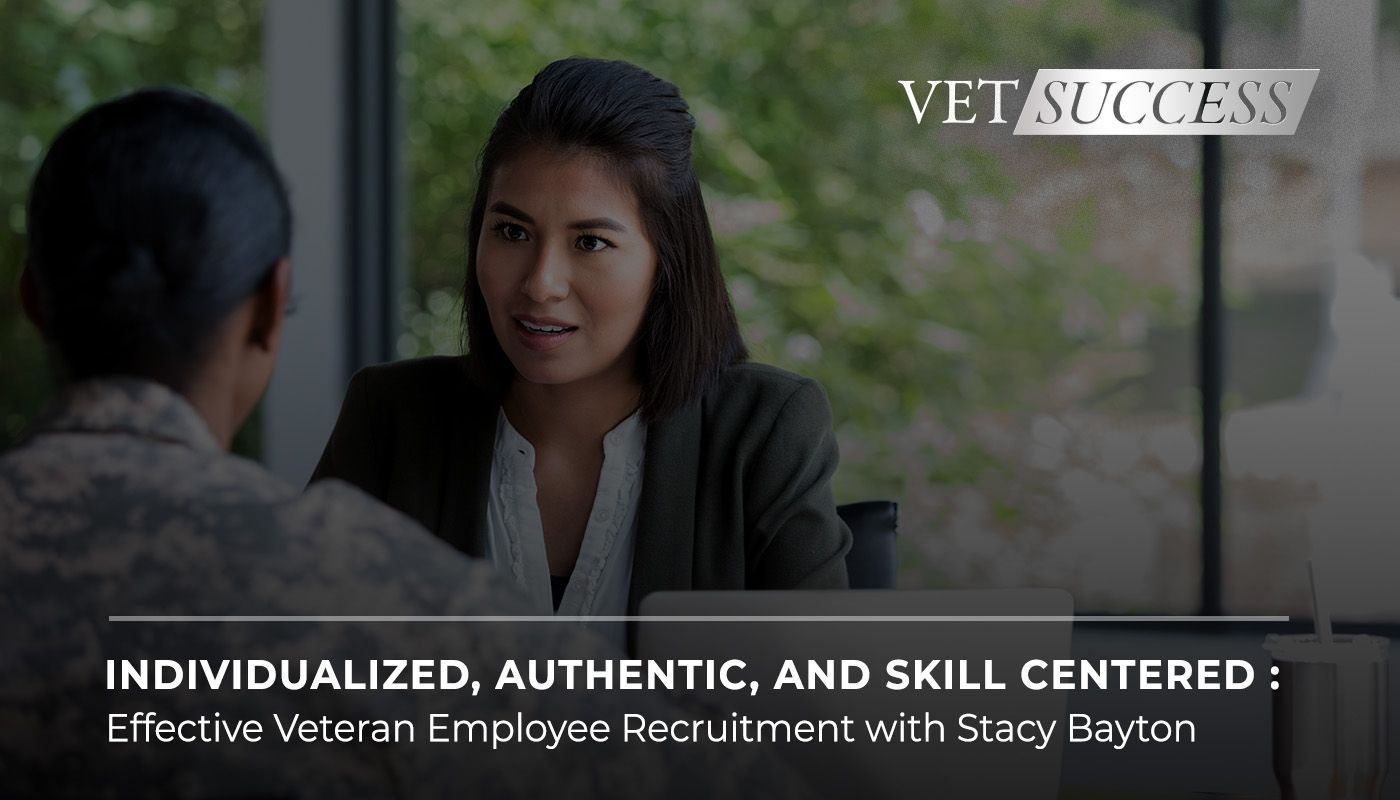
By Ben Biles
•
21 Sep, 2023
Employers have made a concerted effort to attract military veteran talent. With 61% of employers prioritizing veteran hiring in the next five years, there is definite demand for military veterans in the civilian workforce. This demand is highly understandable, as military veteran employees typically have attributes that contribute to companies’ bottom lines, like being dedicated to teamwork, having a strong work ethic, performing well under pressure, and having acute problem-solving skills. Despite the enthusiasm for hiring military veterans, 53% of employers reported needing resources and guidance for veteran recruitment . While there is no one-size-fits all solution for ensuring veterans’ successful transition into a civilian career, American Veterans Group sat down with Stacy Bayton – Senior Executive at VetJobs, Corporate America Supports You – Military Spouse Corporate Career Network (CASY-MSCCN) and Marine Corp veteran, to discuss how employers can improve their military veteran employment efforts. VetJobs is the leading online resource for military-affiliated job seekers looking to attain a rewarding career and maximize their earnings. Over the past two decades, VetJobs has placed over 91,000 Veterans, Transitioning Military Members, National Guard and Reserves, and Military Spouses, into industry leading and high-earning careers. Through its partnership with VetJobs, American Veterans Group has helped 68 veterans transition into rewarding civilian careers. Look at veteran job seekers as individuals. Companies have been eager to hire veterans and military spouses, but would center these efforts, disproportionately, on entry-level positions or positions in very specific industries . While the intent was good, it often led to veterans’ underemployment, and job dissatisfaction. However, as Stacy Bayton shared, there has been a real shift in recent years, where companies are making a more concerted effort to find the best fit for their prospective military veteran employees. “One of the biggest evolutions has been that companies aren’t really trying to fit military into an entry level box anymore. Instead, they’re looking at them as individuals.” Yes, companies need to have employee recruitment and retention programming that is responsive to veteran job seekers’ common challenges and perspectives – but they need to evaluate all candidates as individuals, with unique skills, interests, and personalities. Veterans reflect the diversity of America, and companies need to match veterans with positions that are the right fit. Evaluate your company’s employee branding and how it speaks to military veteran job seekers. Military veterans, like all job seekers, use a variety of methods when they are looking for their next opportunity. An Indeed survey of military veteran job seekers reported: · 62% use online job sites/boards · 58% visit job sites in person · 39% attend job fairs · 37% leverage their personal network · 34% use online social network · 33% connect through recruitment staff · 31% use their local newspaper · 29% use temp agency specializing in Military experience job seekers Veterans will often look to see how “veteran-friendly” an employer is by searching for explicit veteran hiring programs and initiatives, whether the company has veteran representation in leadership and HR, and reading reviews from current and past employees on their experience within the company. For companies to align their employee branding with their veteran recruitment efforts, they should: · Explicitly call out and highlight veteran-centered programming, initiatives, and leadership. · Ensure job descriptions and titles use military-friendly keywords, and skill translations · Train and educate hiring managers and recruiters on best practices for hiring military veterans. · Allocate the appropriate recruiting marketing resources based on the company’s prioritization of veteran job seekers. Bayton stressed how critical open and consistent communication is in the veteran recruitment process, which is central to companies crafting their employee branding strategy and practices. “Be honest… We really encourage open communication and understanding on all sides.” Center skill translation and matching in all military veteran recruiting. Companies and veteran job seekers alike have struggled to translate military experience and expertise to the skills required of different civilian jobs. Employers need to invest in training hiring managers and recruiters on how to translate veterans’ skills so job seekers are placed in positions that best fit and utilize their talents and experience. Bayton emphasized the importance of this skill translation and warned against companies simply directing veterans to their job boards. “We actually want to pre-qualify our people, identify gaps, make sure they’re qualified… We want them to land in the right company and understand their role so they can grow. Then the retention is there. The company is happier, the person is happier. We just do a much better job on both sides when we put a little bit of work into it.” Companies’ military veteran recruiting efforts should reflect the genuine values and needs of each organization. Just as with the non-veteran talent pool, veteran job seekers reflect a wide array of skills and interests that would positively impact organizations at all levels. The key is to take the time and effort to find the right fit. Join the conversation on military veteran recruitment and retention at VetSuccess 2023 .

By Ben Biles
•
09 Sep, 2023
Transitioning to civilian life is an ongoing process, not an end destination. While the U.S. military has the Transition Assistance Program (TAP), it primarily focuses on guiding separation of military members in their education and employment pursuits, and raising benefits awareness. And while education and employment comprise a significant portion of the transition to civilian life, there is much more to consider . Whether its learning to navigate civilian health insurance, finances, housing, shifting family dynamics, or an altered sense of identity and community, veterans are typically faced with significant changes when they leave the military. The impact of these changes does not happen in a vacuum; challenges in certain domains of the transition to civilian life often impact other areas. For example, a veteran who doesn’t know how to best navigate civilian health care costs may experience financial strain, which can, in turn, impact mental health. Or veterans seeking medical assistance may be experiencing food insecurity, which directly contributes to, and perpetuates, their poor health outcomes. There is no shortage of nonprofits providing necessary services to veterans; however, the impact of these efforts is compounded when organizations collaborate to deliver holistic solutions. Veteran-focused nonprofits that primarily focus on veteran employment and education can partner with other nonprofits to provide more comprehensive support for veterans as they transition. Benefits of nonprofit collaboration include: · Providing access to more expansive services without directly taking on the cost of that service · Streamlining costs and mitigating scope and mission creep · Improved organizational efficiency and effectiveness · Broader and more effective impact for served populations · Access to new funding opportunities Collaboration isn’t restricted to nonprofits – companies, universities and higher-education institutions, nonprofits, and government entities can work together to create a comprehensive network of services that ensure veterans are set up for success in all facets of their civilian life. To begin exploring opportunities for collaboration, organizations should: Reflect on organizational gaps, aspirations, and trends . Are there common issues your service population struggles with that your organization cannot address? Are there other organizations delivering the same services as yours, creating competition for funding? What does your organization do exceptionally well, and are there services that complement your existing efforts? Get input from different stakeholders . Survey your colleagues, veterans in your organization, or served by your organization, board members, and other relevant stakeholders to better understand what resources are available and what collaborative opportunities may be worth pursuing. Meet with other organizational leaders . Use insights from your stakeholder discussions and organization reflection to help identify potential partners, and start building relationships. Explore collaborative model options . From joint partnerships on issue advocacy to co-sponsored programming, there are abundant collaborative models your organization can pursue. Which model you select will be determined by the specific outcomes you are aiming to achieve, and challenges you are attempting to overcome. By leveraging each other's strengths, and collaborating on common issues, organizations can build a stronger support system for veterans. Through intentional, and strategic collective efforts, veteran-centered nonprofits, corporations, and higher-education institutions can ensure veterans receive comprehensive assistance to thrive in all aspects of their civilian lives. Open the door for new collaborative opportunities at VetSuccess 2023, October 25, 1-3pm Eastern time. Register now .
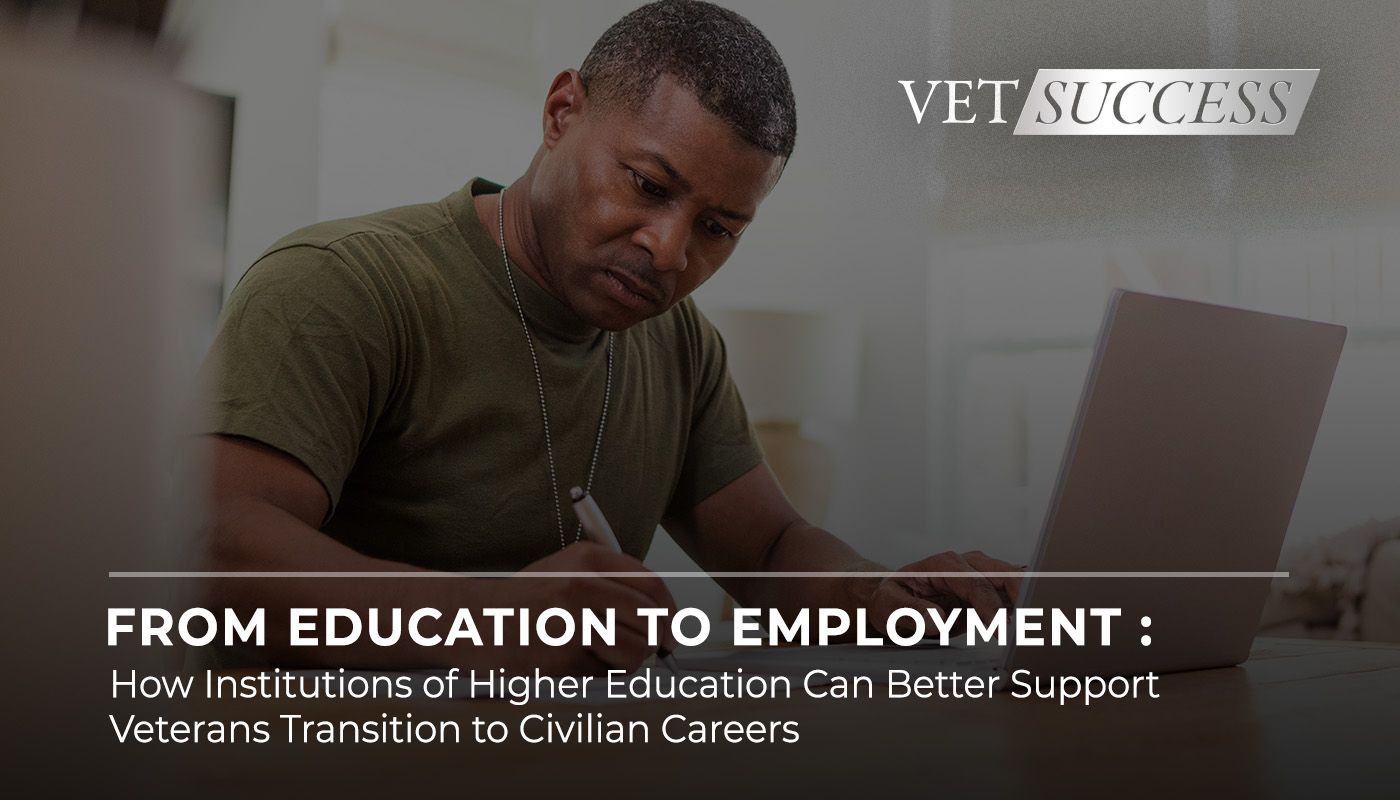
By Ben Biles
•
18 Aug, 2023
One of the most difficult barriers veterans face in their transition to civilian life is finding employment opportunities that are the right fit. Whether it’s an issue of underemployment or cultural misalignment and unfamiliarity, many veterans struggle to find and stay in positions after the service . Universities and institutions of higher education have long been a conduit for veterans transitioning to civilian careers and can play a powerful part in veterans’ long-term career success. Veterans that pursue postsecondary education gain access to numerous experiences and resources that better position them to thrive in the civilian workforce. For example, employers may struggle to translate veterans’ transferrable military experience, but a degree from a postsecondary or vocational institution is a clear indication of veterans’ qualifications. Continued education also provides veterans with the opportunity to upskill or explore industries they may not have had exposure to while in the service. Furthermore, in pursuit of their continued education, veterans become more familiarized with civilian terminology and professional norms and can access valuable networking opportunities. However, while institutions for higher learning offer a myriad of benefits that support students’ career aspirations broadly speaking, they are not always prepared to accommodate student veterans’ specific life circumstances or professional development needs . To best support student veterans’ professional aspirations, postsecondary institutions need to familiarize themselves with the unique opportunities and challenges their student veterans face, both while in school and in the workforce. American Veterans Group sat down with Hudson Miller, United States Marine Corps veteran, recent Harvard University graduate, and former president of the Harvard Undergraduate Veterans Organization to discuss some of the barriers student veterans face, and how universities can better support their veteran student population. How can postsecondary institutions better support their student veterans and set them up for long-term career success? Gain a clear picture of the institutions’ student veteran population. Career development and postsecondary offices that provide student support should keep in mind that the majority of student veterans have similar profiles to other “nontraditional” students. The Institute for Veteran and Military Families and the Student Veterans of America report that 47% of student veterans are married and have one or more children, 85% are between 24 and 40, 62% are first generation college students, and 60% of student veterans are employed, working 35 hours a week on average. Miller emphasized that while student veterans share common life circumstances as other “non-traditional” students, universities need to be careful not to simply lump veterans into this group, and must walk the fine line of accommodating student veterans’ specific needs while not isolating them from the rest of the student population. “Getting them in the door is incredible, but you still need to take care of them – and you need to take care of them in the way they need to be taken care of,” Miller asserted, “not in the way that everyone is being taken care of.” Each postsecondary institution should know the specific demographics of its student veterans to better anticipate and accommodate their needs, whether it be providing flexible course hours, or connecting them with university childcare providers. “You’ve built a program that’s designed to help 18- to 22-year-olds who are single, who haven’t had a job before, and all these things are great,” Miller continued, “but you now need to expand on that.” Universities also need to be prepared to support student veterans transition to campus life – whether it be providing resources and information related to mental health supports, or campus culture guides. The first step in supporting student veterans advance in their civilian careers is removing barriers that may prevent them from exceling in their education, including barriers to social acclimation on campus. Advocate for veteran representation in postsecondary administration. Veteran representation in post-secondary administration enables institutions to better develop policies and resources that enable student veteran success. For example, having individuals in the career development departments of universities who are either veterans themselves, or have been trained in the veteran transition process are better-equipped to place and advocate for student veterans through their job search. The Institute for Veterans and Military Families reports that “campuses with personnel dedicated to serving student veterans were described as being better equipped to engage with employers, VSOs, and community-based organizations.” While reflecting on his own experience transitioning from service to university, Miller said. “If you’re to have success, I think you need somebody within the institution who’s willing to push for you.” Given the different experiences, challenges, and needs of student veterans, it’s necessary for postsecondary institutions to ensure they have a voice at the administrative level. “I think it would be nice to have somebody at the institutional level to be like, ‘hey, this is what our mission is for veterans and this is how we get there,’” Miller said. Create a central student veteran career hub. It can be difficult and overwhelming to find and leverage relevant career resources. By housing this information in a central hub, whether it be a portal on the university’s website, or a monthly newsletter, student veterans can more easily access training opportunities and job postings. For Miller, networking has played a powerful role in both his university and post-graduate success, but he also explained that it isn’t always easy for student veterans to find the connections they need. “Veterans honestly don’t know what they’re qualified to do when they’re looking for internships,” he said, “there’s not a lot of resources for finding internships that are specifically looking for veterans either.” With this in mind, postsecondary institutions can also use these hubs as a repository for student information; for example, student veterans may submit their resumes and preferred industries so the career and development office can connect students with tailored opportunities. By offering tailored assistance, institutions can bridge the gap between military experience and the civilian job market, helping veterans translate their skills and qualifications into meaningful employment opportunities.
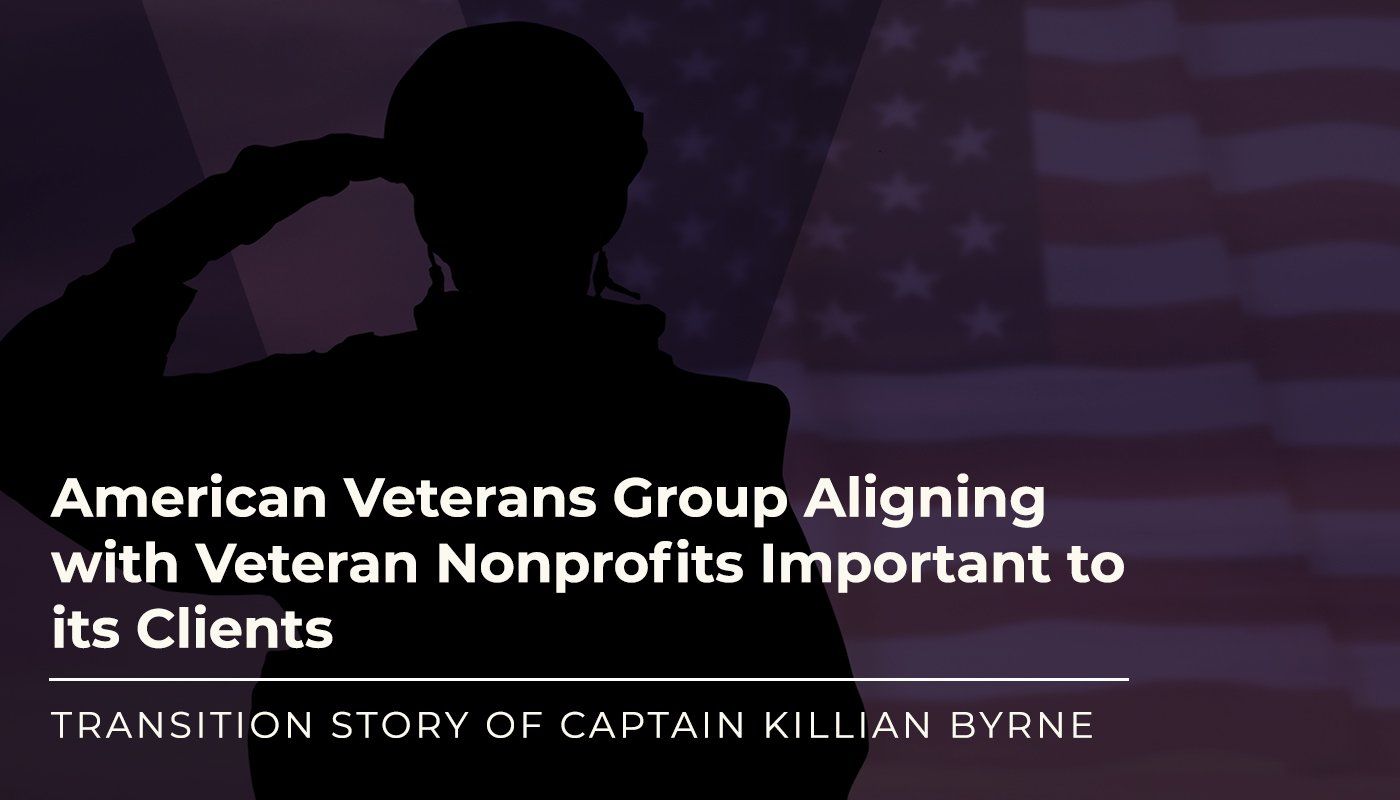
By Ben Biles
•
11 Nov, 2022
Today on Veterans Day we are sharing our final veteran profile in this series highlighting some of the veterans who have benefited from AVG’s philanthropy. We are overw helmed by the success of our Foundation and are even more satisfied at the broader impact all of our corporate clients have made on the veteran community. It’s almost unbelievable to say that we’ve donated just over $600,000 to 37 nonprofits since our founding. The donations our Foundation has made have had a direct impact on the lives of 3,100 plus veterans in 46 American cities. There’s been a tangible, multiplier effect to our giving and that's because we align ourselves with our clients on their social missions to support veterans in their communities. Today, we recognize our clients who make the hiring and training of veterans a key part of their CSR goals and we thank them for the opportunity to share our giving with veteran organizations important to them. We also salute all our service men and women who have served our country bravely. Here’s Killian’s story about how he transitioned from the Marine Corps to landing a great job with Amazon Web Services from the Hiring Our Heroes corporate fellowship program. Transition Story of Captain Killian Byrne Killian went to the University of Pittsburgh on an ROTC scholarship, graduating in 2015. He then entered the Marine Corps officer candidate school. He thought he wanted to be an infantry leader, but after officer basic training he chose to do something more in the supporting establishment. He decided to become a communications officer. His time as a communications officer sent him overseas to Australia, Kuwait, Syria and finally Iraq. In Iraq, he was the single point of contact for all the coalition forces on that base. He linked up and used the combined joint task force network ensuring communications stayed intact. Killian initially enlisted to serve only four years, but served eight years with his last duty station being the Pentagon working in the command control communications and computers office as an action officer. It was his deployment to Iraq that caused him to consider transitioning out of the military. His wife, a dentist, had landed a job after having been unemployed due to Covid for some time and he did not want to risk being deployed overseas again, pulling her away from a job she worked so hard to find. So, in 2021 he began looking at his options for transitioning out. He was hopeful after a friend shared his positive experience with the HOH corporate fellowship program. His friend, who was already transitioning out, shared with Killian how smooth that experience made the job search process. “The hardest part about Marine Corps transition or DOD transition, I would say, is that as much as you’d like to have something lined up for when you're done, companies don't hire a year out,” Killian shares. “So if you're trying to make plans in advance, it's very difficult to plan to transition in one year and then wait nine months to start the job search process.” Killian says you cannot accrue more than 60 days leave, so even if he had planned to take terminal leave, that’s not enough time to find employment. “There’s a lot of stress around that timeline,” adds Killian. “I was lucky in that my chain of command was very open to me doing the SkillBridge process. A friend of mine actually delayed his exit strategy by about a year because he wasn't able to get that time at the end to make his transition smooth.” Because Killian did have a lot of accrued time off, he was able to take that time off to prepare for the application process for the HOH corporate fellowship program. Killian says it took about six weeks to prepare for and finally be selected for his fellowship. During that time, he was completing paperwork and doing informational sessions and interviews. With the help from his program coordinator and support team at HOH, Killian was able to tailor his resume to specific job roles and companies that were in the corporate fellowship pool of opportunities. He said he had about 16 interviews. The preparation paid off. Soon after Killian was selected for a corporate fellowship with Amazon Web Services. The internship was based in Herndon, Virginia, which was only about 40 minutes from where he was living at the time. Killian was able to participate primarily virtually but did go into the office on occasion to meet with teams. “It was full-time every day but on the last day of the week, Hiring Our Heroes reserves that day to provide informational sessions,” says Killian. “Different companies were slotted for those Fridays to talk about various things. For example, Deloitte did a huge presentation talking about the transition from military to civilian life and sharing things like how power structures are organized in leadership roles and some of the unspoken rules and regulations in the corporate sector that aren't as well defined in the military.” Killian’s goal going into the fellowship was to look for a company that was looking for fellows with intent to hire. As his 12-week fellowship was coming to an end he was invited to participate in what Amazon calls loops, which is a part of their hiring process. Killian participated in six different interviews at the end of which he was given a solid job offer that far exceeded his expectations in terms of compensation. “I have been and will continue to recommend Hiring Our Heroes to every transitioning veteran that I know because it is so good to have a mechanism by which to transition,” Killian says. “These companies have a vested interest in hiring veterans. So, you are treated with that priority. Hiring Our Heroes, just mainlines you straight to those folks and it’s made the process so much more manageable and less stressful than just trying to do it on my own.”
324 S. Service Road
Suite 107
Melville, NY 11747
contact@americanvetsgroup.com
(646) 933-8387
Please Click Here
to see our Form CRS for more information.
Please Click Here to check the background of this firm on FINRA's BrokerCheck.
Please Click Here to view our RBC Order Handling Disclosure.
Member FINRA & SIPC | Registered with MSRB
American Veterans Group, PBC © 2024. All Rights Reserved.
Privacy Policy &
Terms of Use.

